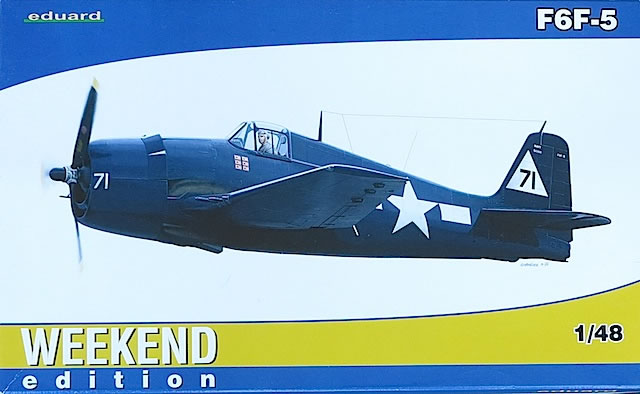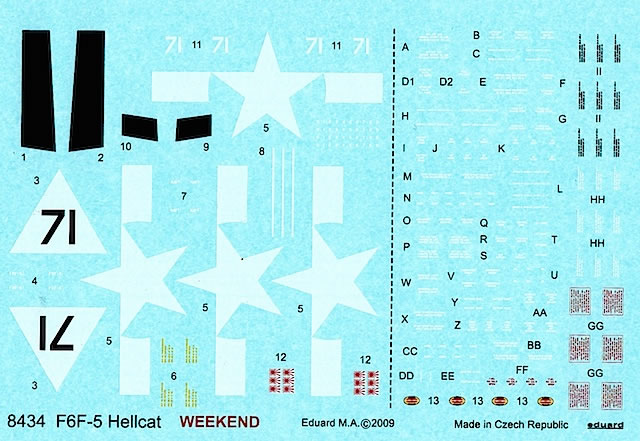|
F6F-5
Weekend Edition

Eduard, 1/48 scale
S u m m a r y : |
Catalogue Number: |
Eduard Kit No.8434 – F6F-5 Weekend Edition |
Scale: |
1/48 |
Contents & Media: |
Approximately 131 olive and grey plastic parts (21 unused); 17 clear plastic parts (6 unused); 1 decal sheet containing markings for 1 aircraft; 8 page black and white instruction booklet. |
Price: |
USD$21.21 plus shipping available online from Eduard’s website |
Review Type: |
First Look |
Advantages: |
Accurate kit; interesting marking option |
Disadvantages: |
Decals have minor quality control issues |
Conclusions: |
This kit’s accuracy, low price, simple paint scheme and ace’s markings make it an attractive proposition for a quick out-of-the-box build. It might even be possible to finish the kit in the course of a weekend! Highly recommended. |
Reviewed by
Brad Fallen

Eduard's 1/48 scale F6F-5 Weekend Edition is available online from Squadron.com
The Grumman F6F Hellcat entered combat in August 1943 and immediately demonstrated its superiority over the A6M Zero and other Japanese fighters. It remained unmatched for the final two years of the war, destroying over 5,000 enemy aircraft for the loss of only 270 Hellcats. The quality of Grumman’s design meant that only two variants were manufactured during the type’s three-and-half-year production run: the initial F6F-3, and the F6F-5 which first flew in April 1944 and accounted for two-thirds of the 12,200 Hellcats built. Arguably the main difference between the two variants was the F6F-5’s ability to carry a wider variety of ordnance, which allowed these later Hellcats to be used more effectively against land and maritime targets. Wartime F6F-5s were camouflaged almost exclusively in overall Gloss Sea Blue, although some postwar F6F-5K drones were painted in spectacular high visibility colour schemes.
Eduard launched its 1/48 Hellcat family in 2008 and, as I noted in my review of the F6F-5 Early Profipack kit, the series now runs to more than ten different boxings. Some earlier releases are now being revisited, such as the F6F-3 Weekend Edition that was re-released earlier this year with different markings to the original 2009 boxing.
Eduard has now reissued its F6F-5 Weekend Edition, which was also first released in 2009. Unlike the F6F-3 Weekend Edition, however, the new F6F-5 kit appears to be a straight re-release, offering the same marking option as the 2009 kit – ‘White 71’, flown by VF-20’s Lieutenant Leo Bob McCuddin off the USS Enterprise during the Battle of Leyte Gulf in October 1944. McCuddin was a five-kill ace awarded the Navy Cross and Silver Star for separate attacks on Japanese ships during the battle. He subsequently flew over thirty missions in F4U Corsairs during the Korean War, before commanding USS Ranger during the Vietnam War in the 1960s.
Eduard’s 1/48 F6F-5 Weekend Edition comes in the series’ eye-catching blue, white and yellow box and is dominated by a large full-colour-on-white-background painting of ‘White 71’ in flight. This illustration, along with port and starboard profiles of the aircraft on the side of the box, are the kit’s only full colour painting and marking instructions – although this is not a problem given the subject’s simple Gloss Sea Blue paint scheme.
The box contains Eduard’s now familiar mix of older khaki and newer grey plastic, drawn from the company’s large number of variant-specific F6F sprues. In this case, the combination of late fuselage and cowl parts (sprues D and J) with late wings (sprue B) allow a mid-to-late series F6F-5 to be modeled, which appears to be correct for McCuddin’s aircraft. A variety of underwing stores is provided, including two types of rocket, which is appropriate for an F6F-5.
The quality of Eduard’s 1/48 Hellcat is well documented, so I won’t go into detail about this (or include too many photos); it’s sufficient to say that the plastic parts, both grey and khaki, are all well moulded with no imperfections and very little flash. The clear parts are also very good and include two different sliding sections, with the slightly wider one to be used when posing the canopy open.
As a Weekend Edition kit, this boxing doesn’t include the photo-etched parts, canopy masks, full colour instruction guide or multiple decal options of Eduard’s ProfiPACK releases. Fortunately, the plastic cockpit parts are well detailed in their own right, and with careful painting will look excellent (although I would probably grab an aftermarket harness from the spares box). And, while I love Eduard’s canopy masks, the F6F-5’s simple canopy framing makes it an easier proposition to mask from scratch than, say, a Bf 109 E.
The black-and-white instruction booklet is definitely a ‘no frills’ production, being smaller and less crisply printed than its ProfiPACK equivalents. However it provides all the information needed to finish the model, including logical and clearly illustrated assembly sequences, as-you-go colour call-outs in Mr. Color paints, and a sprue map identifying which parts are and are not to be used.
Markings
One of the giveaways that this boxing is a re-release of a 2009 Weekend Edition kit is the presence of airframe stencils on the decal sheet. Eduard no longer provides stencils in Weekend Edition kits, presumably to help keep prices down, so in this sense their presence here is a bonus! The stencils are complemented by a three-view greyscale stencil placement guide in the instruction booklet; the guide also includes scrap drawings of the port upper wing, rockets and propeller blade.
The accompanying, black-and-white painting and marking guide is complemented by full colour port and starboard profiles of ‘White 71’ on the side of the box. Given the straightforward nature of the paint scheme, the limited number of markings and the previously mentioned stencil placement guide, this guide is well done and perfectly acceptable. Some of the accompanying historical information provided by Eduard is incorrect, describing the Battle of the Philippine Sea as taking place in October 1944 when it actually occurred four months earlier.

The decals (including stencils) are an Eduard production and occupy one reasonably small sheet of paper. This is unsurprising, given the simplicity of the scheme on offer. Printing is good, although not quite to the standard of other Eduard decals I’ve seen recently: the stencils aren’t really legible, and there is a large fleck of dust trapped between the carrier film and one of the stars. The white stars and bars and identification triangles also appear slightly translucent on the sheet, but I haven’t had a chance to test them yet to see if this is actually the case.
This kit is a welcome reissue by Eduard, with its accuracy, low price, simple paint scheme and ace’s markings making it an attractive proposition for a quick out-of-the-box build. It might even be possible to finish the kit in the course of a weekend!
Highly recommended.
References
Bert Kinzey, ‘F6F Hellcat in Detail and Scale’ (Squadron/Signal Publications, 1996).
Barrett Tillman, ‘Hellcat Aces of World War 2’ (Osprey, 1996).
Thanks to Eduard for the sample and for the images.
Review Text Copyright © 2013 by Brad Fallen
Page Created 20 November, 2013
Last updated
20 November, 2013
Back to HyperScale Main Page
Back to Reviews Page

|
